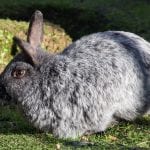Scientific Facts
| Common Name: | Eastern cottontail |
| Scientific Name: | Sylvilagus floridanus |
| Life Span: | Up to 8 years in captivity |
| Size (Adult): | Medium-sized |
| Weight (Adult) | 1.8 to 4.4 pounds |
| Habitat: | Open grassy areas, old fields, clearings |
| Body Shape: | Compact |
| Country of Origin: | North America |
Physical Description

The eastern cottontail is the most common species of rabbits in North America. It is a New World cottontail rabbit that is a member of the Leporidae family. This rabbit is chunky in appearance, has a red-brown or gray color with large hind feet, long ears, and short white tail hence its cute name.
A distinct rusty patch on the rabbit’s tail is present. The male looks different from the female; it has a brown-gray color found around the neck and the head while the body is lighter and has a white underside found on the tail.
The eastern cottontail has large brown eyes and oversized ears that it uses to see and hear danger or threats. During the wintertime, the fur of the eastern cottontail is more gray than brown. The babies will develop the same color after a few weeks of life. The kits will also have a white blaze that is found on their forehead, but this mark will soon disappear as the bunny becomes mature.
The eastern cottontail can weigh from 1.8 to 4.4 pounds and has an average weight of 2.6 pounds. The female is heavier, but the two genders tend to overlap when it comes to size. There is a slight variation in body size of these breeds with weights that seem to increase from north to south according to Bergmann’s rule. Specimens found at the Florida Museum of Natural History weighs around 2.44 pounds while specimens from Michigan averaged 3.1 pounds.
Coat and Colors
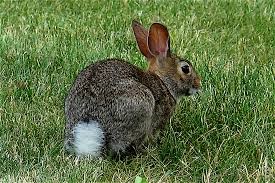
The recognized colors of eastern cottontails range from red-brown to gray-brown. There are distinct color patterns on the body, especially on the head, back, and tail. The kits have the same color after a few weeks but have a white spot that goes down their heads.
Subspecies
There are several subspecies of the Sylvilagus floridanus, and these are classified according to their geographic ranges: eastern cottontails from North of Mexico, Mexico, and Central America and South of Isthmus of Panama.
North of Mexico
- Sylvilagus floridanus alacer
- Sylvilagus floridanus holzneri
- Sylvilagus floridanus chapmani
- Sylvilagus floridanus floridanus
- Sylvilagus floridanus mallurus
Mexico and Central America
- Sylvilagus floridanus aztecus
- Sylvilagus floridanus connectens
- Sylvilagus floridanus hondurensis
- Sylvilagus floridanus macrocorpus
- Sylvilagus floridanus orizabae
- Sylvilagus floridanus yucantanicus
South Isthmus of Panama
- Sylvilagus floridanus avius
- Sylvilagus floridanus cumanicus
- Sylvilagus floridanus margaritae
- Sylvilagus floridanus nigronuchalis
- Sylvilagus floridanus orinoci
- Sylvilagus floridanus purgatus
- Sylvilagus floridanus superciliaris
Fast Facts
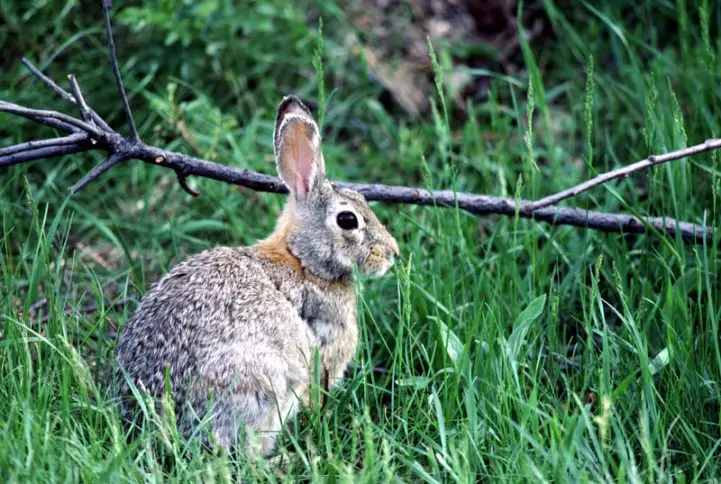
Wild eastern cottontails are very territorial and solitary, but when you get a cottontail from a breeder, this will be calm, sociable, and pleasant. This is why you must not take an eastern cottontail from the wild home to be your pet. Wild animals will never be tamed to become pets under captivity.
Distribution of the Breed

The eastern cottontail can be found in meadows as well as in shrubs in the eastern and south-central areas of the United States, southern Canada, east of Mexico, and the northernmost parts of South America. You will find a large number of eastern cottontails in the Midwest states of North America as well as Arizona and New Mexico.
Because of clearing forests, the eastern cottontail’s range has expanded north. Originally, this breed is not found in New England, but it was introduced in the area and now competes for resources with the New England cottontail. Some people say that the two cottontails appear to look alike.
It was also introduced in US states like Washington and Oregon as well as Canadian provinces like British Columbia. During the mid-1960s, this breed was taken to Cuba, Cayman Islands, Puerto Rico, Barbados, Dominican Republic, Grenada, Haiti, Guadeloupe, and Saint Croix. It is also native to northern Italy.
Temperament
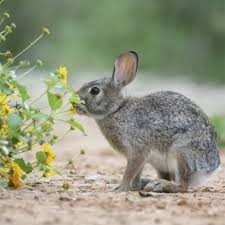
The eastern cottontails are very territorial. When this rabbit is chased, it will run in a zigzag pattern. This rabbit breed prefers an area where it can quickly hide even out in the open. It is found in swamps, bushes, thickets, and also in open areas where hiding places are available. The eastern cottontail can use the dens of groundhogs as temporary homes during wintertime.
Eastern cottontails are crepuscular, which means that these rabbits can spend most of the daylight hours taking a break in shallow areas under vegetative cover. This rabbit can be found at any time of the day. It can feed nocturnally too.
The eastern cottontail is most active when there is less visibility, such as during foggy days and rainy nights, but are known to be active all year long. This rabbit breed can move for very short distances and may even be found sitting without moving like a statue for 15 minutes.
Reproduction in the wild
The time of breeding varies between different cottontail populations and within different populations year after year. Usually, the breeding of wild eastern cottontail happens later when the specimen is located in higher latitudes and elevations.
According to studies, temperature than diet has been the primary factor in the onset of breeding. Also, some people relate to weather or severe weather with the delays in the start of breeding. In areas in New England, breeding starts from March to the middle of September. In specimens found in Alabama, breeding can happen in January and ends in the middle of the year. In Georgia, breeding can last for nine months. In Texas, breeding happens all year long. Specimens found in western Oregon breed from late January to the first weeks of September. The mating behavior of eastern cottontails is promiscuous.
When building a nest for her litter, the female digs a slanting hole from soft soil. She lines it with vegetation and fur. The average size of the nest is 7.09 inches in length, 4.9 inches in width, and 4.71 inches in depth. The average gestation of the eastern cottontail is 28 days from 25 to 35 days on average.
The eastern cottontail babies are born with a fine coat of hair but are blind. Eyes start to open at around 4 to 7 days, and at this time, these newborns are ready to move about and explore their area.
The youngsters begin to move out of their nest in short trips at around 12 to 16 days. These will be completely weaned from their mother and from their nest at around 4 to 5 weeks. At around 7 weeks, the litter will disperse. The mother is not so attached to her litter. She does not stay in the nest for a long time and just returns to the opening of the nest to nurse her young. She will do this twice a day.
By the time the eastern cottontail is three months of age, these are ready to mate. Most females are ready to breed in the spring after birth, but around 10 to 30% breed as youngsters or juveniles (or during the summer season of the year that they are born). Males will mate with females or more than one female.
Usually, female rabbits can have up to 7 litters consisting of one to twelve babies called kits in a single year. The average is from three to four litters yearly. In the south, female eastern cottontails have more litters in a year but fewer young ones in a litter. In New England, the females have around three to four litters in a year. Eastern cottontails can have as high as 35 babies in a year.
Diet in the wild
In the wild, the eastern cottontail has a varied diet and is dependent on the availability of food. These rabbits eat vegetation exclusively. Studies show that there can be up to 145 plant species in the diet of local eastern cottontails.
The natural diet includes barks, leaves, fruit, flowers, twigs, seeds, rush seeds, sedge fruits, and grass seeds of almost all kinds of plants in its habitat. Some cottontail breeds will produce two kinds of droppings, and one of these is re-consumed. This redigestion is said to increase the nutritional values of many dietary items found on rabbit droppings.
During the summertime, eastern cottontails will eat tender green herbs if these are available. In many areas where eastern cottontails are found, Kentucky bluegrass and Canada bluegrass are necessary for the animal’s diet. Other species swill eat clovers and crabgrasses, which are usually available all year long.
Cottontails found in Connecticut will eat summertime foods like clovers, timothy, bluegrasses, alfalfa, quackgrass, crabgrass, dandelion, plantains, ragweeds, goldenrods, redtops, chickweed and more. This rabbit will also consume several domestic crops like wheat, oats, or anything available for them to snack on.
Eastern cottontails are also active during the cold season. This is when even green vegetation is blanketed with snow. These rabbits will readily consume twigs, buds, and barks of woody plants and trees. In Connecticut, winter foods are gray birch, smooth sumac, and red maple, which are available even when the temperature drops significantly.
Predators of the Eastern Cottontail
The eastern cottontail has several predators that can be natural or introduced to their natural environment. Because of their large numbers in eastern North America, cottontails create a major component of many predators’ diets. The major predators include common housecats and dogs, coyotes, foxes, weasels, bobcats, raccoons, minks, barred owl, great horned owl, hawks, snakes, and corvids.
Baby eastern cottontails are very vulnerable, and because the mother returns only twice a day to nurse, the nest is open to many types of predators. Wild animals that take baby cottontails include badgers, raccoons, skunks, and opossums. The eastern cottontails in Missouri are a staple in the diets of red-tailed hawks, especially during the nesting phase. This rabbit is a major component in the diet of great-horned owls.
In the southwest regions of the US, eastern cottontails are a staple in the diets of northern goshawks. In Texas, the rabbit is prey to coyotes, especially in early spring and fall. Finally, the eastern and desert cottontails are part of the diets of bobcats.
The mortality of eastern cottontails has increased due to several factors. In Kansas, 43% of radio-tracked eastern cottontails were killed due to predation, 19% were from research mortalities, and 18% were from tularemia. It was noted that a major cause of the death of eastern cottontails is vehicle collision. In Missouri, it was estimated that 10 cottontails are killed yearly for every mile of road. The highest incident of the collision was during spring, which is March to May. This is because roadside vegetation greens in adjacent fields are attractive to cottontails.
Meanwhile, annual survival in adults is around 20%, while the average longevity is 15 months when the specimen is in the wild. The longest-lived specimen in the wild is five years of age. On the other hand, captive specimens can live up to nine years of age.
Eastern cottontails can be hosts to different pests like lice, ticks, fleas, cestodes, trematodes, nematodes, botfly larvae, shopes fibroma, tularemia, torticollis, and streptothricosis. Because of the eastern cottontail’s ability to become host to these pests, you must never take an eastern cottontail in the wild.
Natural habitats and homes
The wild eastern cottontail has expertly used its natural environment to its advantage. Because of its skill, it uses local foliage as cover, food, nesting material, and as a place to play and explore. Eastern cottontails usually forage in open places and use brushes, stones, and shrubs around them as cover. They will hide within herbaceous and shrubby plants and will create burrows as escape cover, dens, and shelter. A woody cover is essential in the survival of eastern cottontails.
This breed doesn’t dig their dens but will use the dens or holes of other animal species like woodchucks. During the wintertime, eastern cottontails will use woody covers in areas where cover is provided by vegetation during the summertime. The cottontails know that cover is scarce during this season, and it becomes more cautious than ever. Meanwhile, eastern cottontails native to Florida will use saw palmetto as cover when it is foraging in grassy areas.
Most nesting holes are made from grasslands such as hayfields. Usually, the nest is covered in weeds or grasses to confuse predators. Cottontails may also make their nests in orchards, thickets, and in scrubby woods where there are only a few predators around. The average depth of nesting holes in 5 inches, the average width is 7 inches. The female uses fur or grass to line the nest with and make it comfortable and warm for her babies.
Habitat Parameters
Eastern cottontails habitat parameters are important in ponderosa pine, pinyon-juniper, and mixed species. It lives in woodlands with woody debris, shrubby and herbaceous understories, and degrees of patchiness. Eastern cottontails are found in areas in and around farms such as pastures, fields, open woodland areas, thickets with fencerows, forest edges, wooded thickets, and suburban places provided there is adequate cover and nearby food. Some specimens may survive swamps and marshes but will not remain in dense and deep woods.
Fun Facts
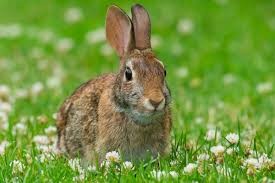
The wild eastern cottontail has unique capabilities that you won’t find in other rabbits. It can leap to distances of 10 and 15 feet to escape predators. It can run at speeds of 15 miles an hour and more to escape as well. You may find an eastern cottontail standing on its hind feet just to check for predators such as foxes, coyotes, eagles, and hawks. It has a unique way of losing predators, too, by leaping from side to side to lose its scent.
Personality

The eastern cottontail is solitary in the wild and may resist any human contact. Wild cottontails will perceive any human interaction as a threat and will never be tamed. But captive bred eastern cottontails are of different personalities. The rabbit will love human contact as long as it is done early on.
Some breeders and owners who have had the rare opportunity to take care of a captive-bred cottontail say that their pets have grown to trust them over the years. They have managed to train their pets and can pet or handle them any time they want.
Care
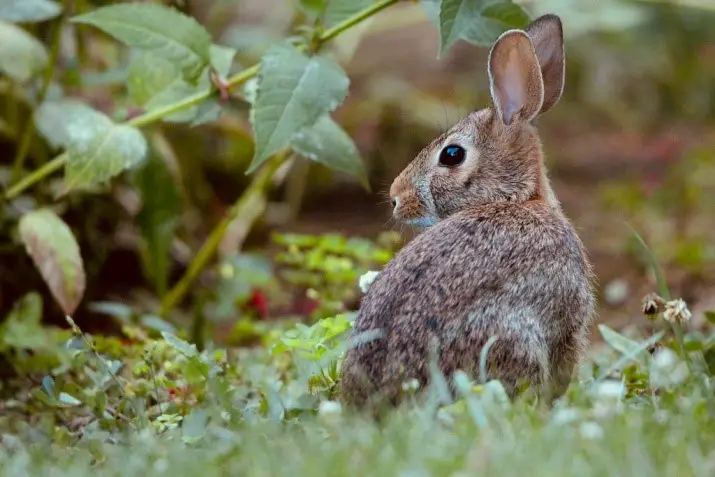
Caring for an Eastern Cottontail rabbit is quite similar to how you care for other rabbit breeds. You must provide the correct diet, housing, companionship, and take it to a vet for proper medical treatment. The main food of rabbits like the Eastern Cottontail is hay.
Hay is the bulk of their diet, and they can chew this all day long if they can. There are also some pellets designed specifically for rabbits which add the needed vitamins and minerals to their diets. You may also add vegetables, and limited quantities of fruit and treats to create a well-rounded rabbit diet. Cottontails will also eat grasses, twigs, birch, the bark of brambles, maple trees, and dogwood.
Take note that when it comes to correct rabbit care, you must ensure that they are provided with unlimited fresh water and hay. This is rough and is very helpful in keeping their digestive tracts healthy and regular. Place the water in a large, heavy shallow dish where the rabbit can easily drink from. A heavy dish is important, so your rabbit can’t knock it over. You may also place water in a flask or container with a spout.
Captive-bred eastern Cottontails are lovable pets for both children and adults, but it can take time to train it. And as a part of being a responsible owner is interact with your pets every day. Rabbits are very social animals, and aside from interacting with their fellow rabbits inside the enclosure, it’s a plus to interact with their owners. Most rabbits thrive well because they interact with their owners every day.
Spaying or Neutering
Spaying and neutering is one way to control the population of rabbits, especially with the promiscuity of eastern cottontails. You don’t want to have a bunch of Eastern Cottontails running about your home, right? This may be done while your rabbits are still at a young age. But some veterinarians wait until their pets reach their sixth month to be on the safe side. And even if bucks can be neutered at a young age, usually as young as three months to make them less aggressive, they are naturally unaggressive. This means that you may not need to neuter your rabbit after all. Consult a vet on the best practice for spaying and neutering your pet.
Supplies and Cages

The home Eastern Cottontails should have a wire enclosure and a removable plastic bottom; this is where the droppings fall, so all you need to do is to remove the bottom for maintenance. The floor of the cage should have soft bedding so that it is comfortable for your rabbit.
You can also place a rabbit hay feeder along the side of the enclosure where your rabbit can eat from when they feel hungry. For the cage bedding, you may use aspen, wood pellets, or pelleted horse bedding. The cage may be cleaned with a safe cleaner or using white vinegar. Avoid bathroom or common household cleaners, which may be toxic for the pets.
Everyday spot cleaning of the bedding is recommended. Rabbits are known to eat their poop, so you need to remove these as soon as you see one. Replace the bedding every week. This is not just good for the rabbit, but also for you as it reduces any annoying smell.
Eastern Cottontails, just like most rabbits, are very clean animals. They will groom themselves and even each other. Sometimes a rabbit can take hours cleaning itself from head to toe taking extra time cleaning under the feet and their ears. Grooming each other may be a social behavior as a way to bond with other rabbits.
Eastern Cottontails are crepuscular, which means that they are mainly active in the daytime and even in the evenings. Their feedings should be done in the evening. They sleep 8 hours a day, on average, and they may do so together, huddled to keep warm.
Also, Eastern Cottontail rabbit is born without fur, and with their eyes closed. They love living in groups, so you may want to consider this if you are planning to take care of a big group of Eastern Cottontails.
Indoor vs. Outdoor Cage
A common dilemma for first-time rabbit carers is where to put the cage in. Consider these pros and cons. Rabbits that live indoors have longer lives and are more social and happy. You can easily take one from their cage and pet them or play with them, which is very important in caring for any type of rabbit.
On the other hand, rabbits that live outdoors are usually skittish and may not be bonded with their owners because you may rarely take them out of their cage to pet them. These rabbits are also vulnerable to weather changes, temperature extremes, mites, predators, fleas, and other complications. This is very important if you live in an environment with extreme climate changes or where it’s too hot or too cold.
If you want to keep your rabbits inside, but do not have enough space, you can prepare an outdoor cage to play and run around. Meanwhile, outdoor cages are the easiest to clean. An outdoor cage also gives your rabbits more room for playing and running around. Take note that that the rabbit cage should be kept away from direct sunlight, and areas with high moisture. The cage should also be well-protected from predators, including other pets such as cats and dogs. You can’t check on your pets as much as you can outdoors, but they will have a lot of space that mimics their natural environment.
Health Concerns

Eastern Cottontails are very hardy rabbit breeds, but these are not immune to common rabbit diseases as well. With this in mind, you must always be mindful of your rabbit’s state of health and overall temperament and behavior. Any change could be possible signs of illnesses. They should also receive standard vaccinations. A vet can help you with your rabbit’s vaccinations.
Some rabbit breeds have sensitive digestive systems and may be more prone to different health issues that plague the gut. You must have your rabbits checked against enteritis, bloat, and gut stasis, especially in rabbits that are less than 8 weeks old. Check for ear or fur parasites like mites, fleas, and ticks. This is often a result of poor hygiene, poor husbandry, and lack of animal management.
Also, be very wary of ill-health signs like poor appetite for eating or drinking, nasal and eye discharges, diarrhea, and vomiting. An unsteady gait, restlessness, grating of the teeth, and sleepiness must also be checked at once.
De-worming is also recommended for Eastern Cottontails. This is a major concern in all rabbit breeds and needs to be completed in the spring and fall. You can use a pea-sized amount of de-worming paste and put it in the rabbit’s mouth. You may consult a vet for the best de-worming product.
Teeth
Part of taking care of Eastern Cottontails involves regular dental check-ups. This makes sure that their teeth won’t overgrow. This is why rabbits chew so much. Their teeth tend to grow very long, and when this happens, the teeth can grow right into the rabbi’s mouth and jaws. This is extremely painful for the rabbit.
A diet high in hay is recommended as it files down the rabbit’s teeth naturally as they chew. Keep an eye on this, so you can save yourself from the expensive vet and dental bills.
Grooming
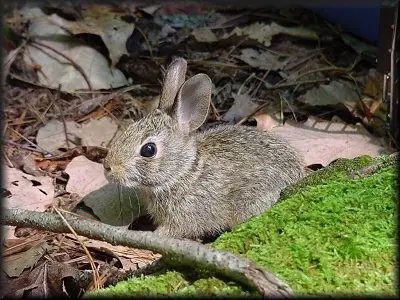
Eastern Cottontails have short fur but will also need regular grooming to keep their coats clean, shiny, and perfect. You must groom it with a small brush at least once a week. You may even do it more when they are in their molting period, to prevent wool blocks and fur ingestion. Because of rabbits usually self-groom, they can lick the fur and ingest it. Fur can accumulate in the digestive tract causing blockage and other complications.
And even if your rabbit is very dirty, you should never give it a bath because this can stress them. You can use a damp towel to spot clean them. Just wipe the rabbit down with the towel and use a dry one to dry off their fur. Trim their nails every month and check for overgrown teeth. If you don’t have a trimmer at home, ask the vet to do this for you. Your vet may also check and clean the large rabbit ears.
Breeding
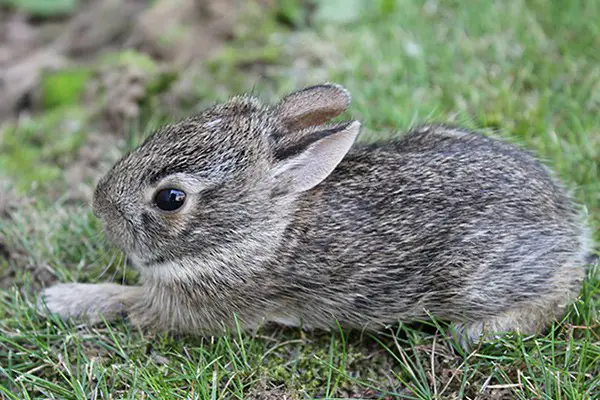
Eastern Cottontails should be at least 6 months or older before they can start breeding. The bucks can be younger, but it’s best to wait until 6 months. For male rabbits, make sure that their testicles have dropped before these are able to breed. The gestation period of a rabbit is usually 28 to 33 days, while most of the females deliver their babies on day 30-31.
Before starting to breed Eastern Cottontails, choose a date that you want for birth. This is important so that you can be at home to provide the doe her nesting area. You must plan ahead to ensure that you will be present for two months when the babies need to be with their mother and to avoid any problems before the babies are weaned.
Rabbits may conceive and give birth at any time of the year, so consider the perfect time for your pet to do so. During the hot summer months, the babies can make the mother uncomfortable, but during wintertime, it’s too cold for the babies who are usually born hairless. Remember that if the mother does not do well, the mother and her babies could all die. Therefore, spring and autumn are the best times to get pregnant.
Other Notes
Just like other breeds, Eastern Cottontails love chewing on things. They can chew on wooden furniture, and even electrical wiring. To avoid these mishaps and potential accidents, give your pet hay or chew toys aside from their food.
Also, make sure that everything that goes to their mouth has not been sprayed with herbicide or pesticides. Younger rabbits may need alfalfa hay since this is rich in calcium, which is needed for growing bones. The adult cottontails love legume hay. Be careful about giving just any yard clippings to your rabbits.
Just like any rabbit, cottontails should be kept in pairs for the reason of companionship. Experts say that being with another rabbit contributes to the happiness of the rabbit, and may help the rabbit live longer. In the wild, cottontails are extremely social, so you must mimic this in a captive environment.
Availability – Where to Get One?

The cost of purchasing an Eastern Cottontail depends on whether you are getting it from a breeder or a retailer. Price may also depend on whether you are getting a rabbit to be used for a show, or as a pet.
When looking for a reliable breeder, it is very important to make sure that you are getting a rabbit that is healthy and not one with genetic disorders like hooked spines or malocclusion. You must buy only from reliable breeders who will breed these traits selectively. And if you want your rabbit for a show, you would also want to have a purebred specimen with no genetic disorders.
How to Care for an Eastern Cottontail
Caring for an Eastern Cottontail rabbit is similar to caring for other rabbit breeds. Provide your pet the correct diet, housing, companionship, and take care of its medical and health needs. Take it to a vet for proper medical treatment.
Feed it the right kind of food. The main food of rabbits like the Eastern Cottontail is hay, which is the bulk of their diet, which they can chew all day long if they can. There are also pellets designed specifically for rabbits, which add the needed vitamins and minerals to their diets. Feed it fresh and organic vegetables and fruit for a well-rounded rabbit diet.
Provide unlimited fresh water and hay. Hay is rough and is very helpful in keeping their digestive tracts healthy. Also, hay can help trim their teeth in the right size to prevent overgrowth. Place the water in a large, heavy shallow dish where the rabbit can easily drink from or in a flask or container with a spout.
Captive-bred eastern Cottontails are lovable, but loving your pet is also being a responsible and well-rounded owner. You must constantly interact with your pets every day. Captive rabbits are very social, and aside from interacting with their fellow rabbits inside the enclosure, it’s a plus to interact with their owners as well. Just keeping an eastern cottontail rabbit locked inside its cage and ignoring it can make it skittish, stressed, and ill. Many rabbits don’t survive being locked up inside a cage without any companion or human interaction.
FAQs
Can you tame an eastern cottontail rabbit?
No, you can’t tame a wild eastern cottontail rabbit because it is naturally cautious will resist human contact. You can tame captive-bred eastern cottontail rabbit, though, because these are just like any other domesticated rabbit.
Will an eastern cottontail rabbit bite you?
An eastern cottontail rabbit will likely run away from a threat and will not take it head-on and bite it. It will also likely jump away because it can jump many feet in the air to escape predators in the wild.
Can an eastern cottontail rabbit become pets?
We caution against getting an eastern cottontail rabbit in the wild to make it as pets. These cannot be tamed and thus will never become good pets; the only captive-bred specimens will make excellent pets for families.
Is it legal to own an eastern cottontail rabbit?
In some places, this rabbit is considered illegal to own or keep an eastern cottontail rabbit at home while some permit it because it is considered the game. If you don’t know the regulations in your area, consult a local animal bureau in your area.
What do you use to trap an eastern cottontail rabbit?
It’s impossible to trap an eastern cottontail rabbit because it is quick, very agile, and smart. But hunters usually set up traps like nets or will just shoot them if they can. Usually, an eastern cottontail rabbit gets away because it’s smarter and faster.
How fast can an eastern cottontail rabbit run?
An eastern cottontail can run up to 15 miles an hour. It can outrun many animal predators, and because of its ability to lose its predator, it can evade hunters year after year.
Is an eastern cottontail rabbit afraid of people?
An eastern cottontail rabbit is generally afraid of almost anything. It can run at the first sign of a threat and will remain still to trick the threat. It is not really afraid of people, but it perceives something different like people; it will quickly run away.
Where do eastern cottontail rabbits live?
Rabbits like the eastern cottontail rabbit burrow into the ground where it can remain hidden from the predator, where it can sleep and where it can lay its young.
Can you hit an eastern cottontail rabbit while driving?
Yes, in fact, collisions are one of the most common reasons why eastern cottontail rabbits die each year. The reason why this happens is that the rabbit perceives that the vegetation at the other side of the road is richer, and hence, it wants to cross the road.
Where can you find the eastern cottontail rabbit in the wild?
You can find eastern cottontail rabbits in the wild near forests, meadows, and clearings for as long as there is a certain amount of cover it can use to deter predators.
Where do eastern cottontail rabbits build their nests?
The eastern cottontail rabbit usually uses the nest of other burrowing creatures, but it may also make her own burrow to lay eggs and line it with fur and grass.
Will the eastern cottontail rabbit breed any time of the year?
Yes, this breed will mate at any time, and this will result in an overpopulation of eastern cottontail rabbits in an area. This is why you must control the population by spaying or neutering.
How often will an eastern cottontail rabbit breed?
It will breed up to many times a year, and a single female may have more than 30 young rabbits in a year.
Can an eastern cottontail rabbit eat their young?
There are no records of female eastern cottontail rabbits eating their young, but if you spot this, don’t panic. Just remove the female from the nest.
Are eastern cottontail rabbit good parents?
In our opinion, the eastern cottontail is not good parents because these will leave their nests alone and vulnerable. It has been observed that the eastern cottontail rabbit will abandon its nest long before the babies leave their nests.
How many young rabbits are born each year?
You can get as much as 35 young rabbits are born from a single female, and sometimes, females will breed immediately after a year of birth, which means they can get pregnant after just a year.
How do eastern cottontail rabbits mate?
These mate with each other and in a promiscuous way.
How do female eastern cottontail rabbits construct their nests?
They borrow or steal the nests or dens of other animals, but they can make their shallow nests in soft ground and line this with fur and grass to keep her young warm.
Do eastern cottontail rabbits feed their young?
Yes, mothers are known to breastfeed their young. They can feed their young, but won’t stay long inside the dens and will only return twice a day to feed them.
How soon do eastern cottontail rabbits mate?
The eastern cottontail rabbit males and females will mate soon after these turn a year old. Meanwhile, some rabbits will breed even before these turn a year.
Why does the eastern cottontail rabbit stand on their hind legs?
The eastern cottontail rabbit will stand on their hind legs to check on its enemies. It will stand even in an open field for minutes just to make sure there’s no threat.
Do eastern cottontail rabbits make a sound?
No, the eastern cottontail rabbit doesn’t make a sound.
How can you tell that the eastern cottontail rabbit is happy?
In captivity, eastern cottontail rabbits may show their affection by playing and following its owner. In the wild, happiness is playing alone in a field or simply jumping and leaping around.
Is an eastern cottontail rabbit nocturnal?
It can be nocturnal in some days, but it is usually active in both daytime and nighttime. It is recommended that you feed your rabbit at night instead of offering food during the day.
What does the eastern cottontail rabbit eat?
The eastern cottontail rabbit is a herbivore, which means it will eat plants, fruits, and vegetables when these are offered. In the wild, these will eat almost any food available, including plant twigs, barks, fruits, seeds, and leaves.
Can eastern cottontail rabbit eat hay?
Yes, captive rabbits will eat hay, and in fact, hay is vital in their daily diets because it helps enhance digestion and will keep the rabbit teeth filed down and avoid overgrowth.
Will eastern cottontail rabbits eat fruits?
Yes, these will eat fruits when offered when in captivity. In the wild, the fruit is scarce, and thus, it can eat fallen fruits, plant parts, and other food items it can find on the forest floor.
Can you keep an eastern cottontail rabbit inside a cage?
Yes, you can keep an eastern cottontail rabbit in captivity. But we don’t recommend getting a rabbit in the wild and taking care of it as a pet because it has a wild nature that will never be removed.
How do you train an eastern cottontail rabbit?
Some breeders say that captive eastern cottontail rabbits may respond to clicker training while some say that it is possible to do so.
Can you buy an eastern cottontail rabbit from a dealer or breeder?
Yes, you can buy baby eastern cottontail rabbits from a dealer or a supplier, but make sure that these are reputable breeders to ensure a healthy rabbit.
Is eastern cottontail rabbit hard to breed?
This is one of the easiest to breed because these rabbits will mate as soon as they can give birth to their young.
Has anyone successful bred an eastern cottontail rabbit?
Yes, many breeders have successfully eastern cottontail rabbits, and it takes love, attention, and care. And as mentioned, this breed is very easy to breed, and thus, many have tried and successfully bred an eastern cottontail rabbit.
Will a pet eastern cottontail rabbit know it’s a name?
No, some owners don’t agree that it can remember its name. Although these rabbits can remember its owner and the surroundings.
Will a pet eastern cottontail rabbit abandon its young?
At some point after the birth, the mother will stay in the nest possibly to check on her babies, but soon, she will only return to the nest two times a day (one in the morning and another in the evening) just to feed her young. After feeding, it will return to her habitat.
Why do eastern cottontail rabbits stand on their legs?
Cottontails have a weird way to check on threats, and that is to stand on its hind legs. It will do so to watch out for enemies that may be lurking nearby. It can remain this way until after a few minutes.

